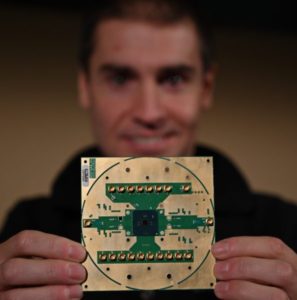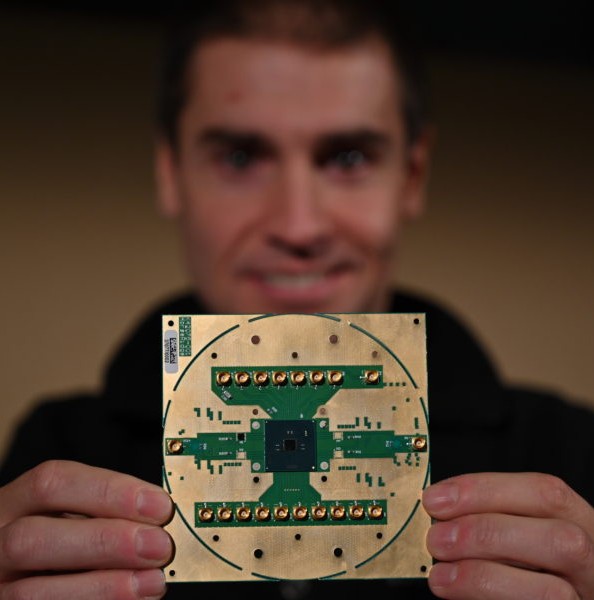
Stefano Pellerano, principal engineer at Intel Labs, holds Horse Ridge. The new cryogenic control chip will speed development of full-stack quantum computing systems, marking a milestone in the development of a commercially viable quantum computer. (Credit: Walden Kirsch/Intel Corporation)
At the International Solid-State Circuits Conference this week, Intel presented a research paper demonstrating the technical details and experimental results of its new Horse Ridge cryogenic quantum computing control chip. The paper highlights key technical capabilities of Horse Ridge that address fundamental challenges in building a quantum system powerful enough to demonstrate quantum practicality.
Building fault-tolerant, commercial-scale quantum computers requires a scalable architecture for both qubits and control electronics. Horse Ridge is a highly integrated System-on-a-Chip (SoC) that provides an elegant solution to enable control of multiple qubits with high fidelity—a major milestone on the path to quantum practicality.
Horse Ridge Features
- Horse Ridge is a highly integrated, mixed-signal, cryogenic SoC on a 4 x 4 mm2 silicon, implemented on Intel 22nm FFL (FinFET Low Power) CMOS technology. It integrates SRAM, digital core and analog/RF circuity into a single package to manipulate the state of the qubits in a quantum system with microwave pulses.
- Integrated, high-speed digital-to-analog converters and wideband up-converter ranging from 2 to 20Ghz
- The amplitude and phase modulation information for pulse shaping (18Gb/s) is stored in on-chip SRAM, allowing envelopes up to 41μs, which are referenced by a look-up table (LUT) that can define 8 instructions per qubit.
Leveraging the LUT reduces the required data rate to the controller, which is further reduced to ~1Kb/s by the integrated programmable instruction set executed on external trigger with minimal delay between instructions. - Horse Ridge features four radiofrequency (RF) channels in a single device and leverages frequency multiplexing to control up to 128 qubits. Each RF channel uses direct digital synthesis with 32 numerically controlled oscillators to generate each of the 32 multiplexed qubit frequencies with high precision of 200 Hz.
Key Benefits
- Reduced form factor (chip and PCB size) and power required to operate quantum systems.
- Ability to scale to and control a larger number of qubits (up to 128 qubits)
- High flexibility in control pulses that can be generated with Horse Ridge reduces crosstalk among qubits with improved overall gate fidelity.
- The device can automatically correct phase shift, which occurs when controlling multiple qubits at different frequencies with the same RF line, with a digital codeword update after each pulse of the control electronics.




